Discovered in Spain a new mechanism for the creation of blood platelets
Thursday, January 29, 2015
Some few days ago, I could found a heartening news, for patients with low blood platelets: “It was discovered in Spain a new mechanism, able to form platelets in blood”.
A study by the National Cancer Research Centre (CNIO) has shown that cells, originating from platelets, the megakaryocytes, can be reprogrammed, artificially, to platelets and reconstitut their blood levels.
The results of the research, published by the Group Cell Division and Cancer of the CNIO, in the journal Developmental Cell, may help in the treatment of thrombocytopenia and promote the design of better therapeutic cancer treatments, as explained by the study director, Marcos Malumbres.
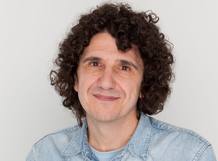
Marcos Malumbres
The Thrombocytopenia is a disease, characterized by a lower than normal platelet index, a tiny cells, involved in blood coagulation, has been reported, by the CNIO, in a note.
Patients with thrombocytopenia, often, suffer uncontrolled bleeding, that can lead to bruising and bleeding, and even death.
Platelets are produced, in a very peculiar way and rare in humans, even in other animal cells: megakaryocytes grow, during their development, until they become giant cells, later 'broken' and form tiny cells, that are platelets.
This impulse growth occurs through multiple rounds of replication of genetic material, cells resulting larger cells, in a number of complete sets of chromosomes, higher than the usual.
Thus, understanding how these cells are produced, in body, could be very useful to alleviate the disease, whose incidence increases, exponentially, in patients undergoing treatments, like chemotherapy. In the latter, such is the severity of the symptoms, that they may be grounds for termination of treatment.
Using genetically modified mice, the Malumbres group has explored cell growth agents, that orchestrate this process.
"While the elimination of the major proteins, that regulate growth of megakaryocytes, generated, as expected, a decreased platelet production, when we remove Cdk1 [a very important protein in the process] this does not happen", says Malumbres.
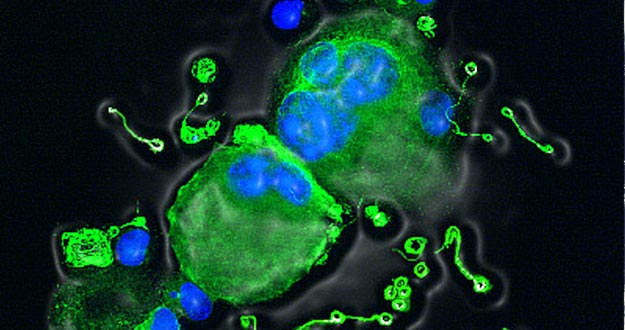
Two deficient megakaryocytes, from which emanates extensions, in which platelets are produced
To this, he added that "even in the absence of Cdk1, megakaryocytes are able to grow in size, similar to normal cells so".
Marianna Trakala, first author of the work, studied, using advanced techniques of videomicroscopy, how it could be that megakaryocytes increased in sized and they produced platelets.
"This analysis revealed that Cdk1 deficient cells, undergo cell reprogramming towards a process known as 'endociclos', which also occurs, in other cell types, such as cells of the placenta", explains Trakala.
Thus, endociclos allow increase in size megakaryocytes, as an alternative to the usual way. "This behavior is a result of the plasticity of cells, to respond to different situations of stress", he concluded.
The identification of this new route, to generate platelets, is not a simple scientific curiosity, but it could have medical applications.
"We, immediately, asked if reprogramming the cell cycle, towards endociclos, we could fix induced thrombocytopenia, in other models", says Malumbres.
For it, his group, in collaboration with groups of Juan Mendez, Sagrario Ortega and Mariano Barbacid, also from the CNIO, eliminated Cdk1, in mice, with severe thrombocytopenia. Removing Cdk1 was able to increase the number of platelets and reduce thrombocytopenia, in these animal models.
According to the authors of the study, the ability to reprogram these cells, may be useful, in various situations, where it is necessary to recover a thrombocytopenia.
The results, they predict, could also help "design better therapeutic cancer treatments, in describing the different requirements than normal or tumor cells have, towards cell cycle regulators".
"Cdk1 blocking or other cell cycle protein is lethal to tumor cells, but does not affect megakaryocytes, suggesting the potential use of inhibitors against these factors already available in various malignancies such as leukemias promegacariocíticas".
The work has been funded by the La Caixa Foundation, Fundación Ramón Areces, the Ministry of Economy and Finance, the Community of Madrid and the European Union.
Well, I hope this work can help many people.
Until my next post, kind regards,
Luis.
Sponsored by Costaluz Lawyers.
Please click below:

 0
Like
Published at 11:43 AM Comments (0)
0
Like
Published at 11:43 AM Comments (0)
Comparing the origin of the Canary Islands (South of Spain) with the origin of Hawaii
Wednesday, January 28, 2015
Once again, we can read a news about the volcano, which erupted, in the island of El Hierro, the last month of November 2011.

Image of the volcano in El Hierro, by satellite
 y la erupción volcánica submarina en azul más claro, en 2011.jpg)
La Restinga (El Hierro) and the volcanic underwater eruption, more light blue
Yes, the geological origin of the Canary Islands is close to the model of Hawaii (USA), as the Canaries is not located in an area, where the plates collide; but in half of the African plate.
This was revealed by a study by scientists, at centres in Sweden, Spain and Portugal, published in Scientific Reports, of the Nature group. It has studied the volcanic materials, that emerged to the surface of the sea, after the submarine volcanic eruption, on the island of El Hierro, in October 2011.
And it is that nannofossils (microscopic fossils), which they contain, confirm that the islands were formed, from east to west. It is an enlightening data, on the origin and life cycle of oceanic islands, which has been discussed, since the beginning of geology, as Sync reports.
"Our study confirms, at the first time, that underwater activity, that begins construction on the islands, follows the pattern of known age progression of subaerial volcanism --emerged part of the islands--, with older ages, in the east of the archipelago, Fuerteventura and Lanzarote; and younger, in the west, Hierro and La Palma”, said Vicente Soler, a researcher at Canary Volcanological Station (CSIC).
"In the Canary Islands, a chain of islands was formed, as the oceanic plate was moved, over a deep magmatic fixed focus, as opposed to the theory, that attributes the origin of the archipelago to the regional tectonic, responsible, among other things, the formation of neighboring Atlas mountains of northern Morocco", said the scientist.
Soler explains that these floating volcanic materials are colloquially known as restingolitas, while, in the scientific literature, they were baptized with the confusing name xenopumitas.
"There is a scientific controversy about what the restingolitas are and their origin. The materials of interest, for this study, were collected, floating at sea, in the early days of the eruption and one week, after arrival at the coast", he adds.
For small fossils they contain, they are attributed to the Cretaceous period, in full formation of the Atlantic ocean with America, which are separated from Europe and Africa, today.
In the opinion of the researchers involved in this work, among which is also Valentin R. Troll, University of Uppsala, and Juan Carlos Carracedo, University of Las Palmas, these fragments would be bits of sediment preisland encompassed and 'reworked' by the magma column on its way to the surface, where the eruption occurred.
"Furthermore, by its silica content, it seems to be a rhyolite rock, related to a type of potentially dangerous volcanic activity. But the existence of Nannofossils, within the restingolitas, is a strong argument, in favor of the first hypothesis", says Soler.
In July 2011, on the island of El Hierro, the first signs of a possible volcanic eruption, in the form of low-intensity earthquakes, were perceived, but unusually numerous. The seismicity became increasingly intense, until October 10, 2011 ended with the beginning of the submarine eruption about 2 miles south of the town of La Restinga.
Well, I hope that you have liked this post and you can come to our Canary Islands.
Until my next post, kind regards,
Luis.
Sponsored by Costaluz Lawyers.
Please click below:

 0
Like
Published at 11:26 AM Comments (0)
0
Like
Published at 11:26 AM Comments (0)
How to restore vision in Spain
Tuesday, January 27, 2015
Yesterday, I could watch a surprising video, where they explained how a young woman was able to restore her vision, thanks to a new device, adapted on a special glasses, invented in Spain.
If you want to watch this video, please click below:
http://www.rtve.es/alacarta/videos/telediario/tdfs4-ojo-bionico-250115/2964403/
Voice in off: “Inseparable of her special glasses, she has gained autonomy and security, she tells us”
Aurora: “At least, now, I distinguish that here, on the left, there is a door ...., that here, there is a window….”
Voice in off: “Aurora began losing her vision, when she was 13 years old; a Retinitis pigmentosa left her blind to 30. Six months ago, she underwent a complex intervention, in order to implant a microchip, in the retina; in her glasses, a camera, with high resolution, captures the image, which then it sends to a small computer”
Aurora Castillo (She has a bionic eye): “The computer, in turn, sends it to a receiver, that I have here, on the right side, a receiving antenna, which is connected to the chip (the retinal stimulator, which I have put in the retina) and that goes, through the optic nerve, to the brain and the brain is interpreting the images that I am seeing”
Conxa Parramón (Voice in off): “Her field of vision reaches the size of a sheet; she can see shadows, distinguish motion, contours ... ,all in black and white. Because she has visual memory, she learns to interpret what she sees: the reality”
Aurora: “Look, I get up the glasses and I see nothing ... I see everything in white. However, I wear it and, at least, I distinguish that there is something, in front of me; I distinguish your shoulder, the other shoulder, your head…”
Jeroni Nadal (Ophthalmologist. Barraquer Ophthalmology Centre): “The issue is how performance has the patient in this visual field; and this is increasing gradually and progressively”
Aurora: “I should resign myself….., hopefully, I could go walking alone in the street; that would be my goal”
Conxa: “Her dream: to look at her child and find out how is his face”
Well, in this sense, I hope that researches continue working, in order to get the Aurora´s dream and others from another people.
Until my next post, kind regards,
Luis.
Sponsored by Costaluz Lawyers.
Please click below:

 0
Like
Published at 11:10 AM Comments (0)
0
Like
Published at 11:10 AM Comments (0)
Transplant fingers in Spain
Monday, January 26, 2015
Yesterday I saw, on the Internet, a news that impressed me: In Spain, become successful transplant toes on hand.
Indeed, the surgeon´s team, Francisco del Piñal, in Cantabria, has exceeded 400 operations, with 99% success. They have already helped many people, who have had amputations, by accident or birth defects. I would like to show you a video, that explains very well what this technique is. If you want to watch the video, please click below:
http://www.rtve.es/alacarta/videos/telediario/tdfs3-manos-250115/2964174/
Francisco del Piñal (Surgeon): “Right now, it still has wounds….”
Voice in off: “Jorge lost his thumb, climbing, a month and a half ago. It seemed very strange the possibility of retrieval, by transplantation of big toe; but, he decided to do so, knowing the numerous precedents, with a favorable outcome”
Jorge Rodríguez (Thumb transplanted): “Sometimes, I see improving it enough, you see fewer scars, it is a little less thick, because, at first, it is swollen, everything is very thick, you have much scar ... but, well, I am happy, by the moment”.
Voice in off: “Amets also lost her thumb, in an accident; she was only two years old……….They have spent four, since it was transplanted the finger to her and the scar is the only sequel to what happened ....... Transfer toes, to the hand, holds a key to success: the correct connection of all structures: arteries and veins have between half and one millimeter, in diameter; microscope must intervene”.
Francisco: “We go to the hand and connect it....; but, before, this is synthesized; after, tendons; and nerves after; and what gives life to the finger: that is the artery, in order that blood goes in and vein, to leave it”
Voice in off: “Lucia's case is different: she was born with the thumb and pinky short; it was lengthened by them and implanted two toes, to configure this hand, with which she greet us”
Paula Cuesta (Lucía´s mother): “The result we have there. The girl .... gets by on her own perfectly, she plays .....”
Juan Carlos de la Fuente (Editorial office Cantabria): “Antonio suffered an accident two years ago,that brought his left hand, at the level of the wrist. On the stump, with 3 toes and metatarsal, Dr. Piñal built in two operations, this funcionale limb, with strength and sensitivity, which allows him to get by on his own”
Antonio Fernandez (Transplanted): “And you see, over time, that you can cut a steak, you can tie your shoelaces, you can drive --in fact, I already drive—“
Juan Carlos de la Fuente: “For all, the accident has left a bad memory, almost erased by a new opportunity, offered by their own body”
Well, I think that it it incredible; therefore, I should like to tell congratulations the Doctor on his work, because it can help many people.
And I hope that researches continue studying, in order to discover other advances, to help much more people.
Until my next post, kind regards,
Luis.
Sponsored by Costaluz Lawyers.
Please click below:

 0
Like
Published at 11:56 AM Comments (0)
0
Like
Published at 11:56 AM Comments (0)
Porra from Antequera in the South of Spain
Friday, January 23, 2015
I did not know this dish, until two years ago, more or less, when I ate it, at home. And I liked very much. Today, I want to share with you the recipe of this typical dish, from Antequera, Málaga, in the South east of Spain.
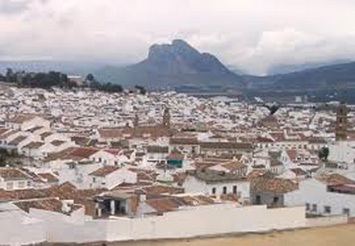
Antequera
It is named: “Porra Antequerana”.
These are the Ingredients, for 4 persons: 1 kg of ripe tomato branch. 400 grams of bread crumbs village. A red pepper. A green pepper. A clove of garlic. 200 grams of virgin olive oil. Sherry vinegar, to taste. Salt. And to accompany: Grated egg yolk. Chopped green and red peppers.
To cook this dish, you need to spend 20 minutes.
You have to do this one: Wash all vegetables. Next, peel the tomatoes and scoop out the seeds. In a blender cup, put the meat tomatoes with peppers, chopped --reserve a piece of each, for garnish--, garlic and bread crumbs, cut into pieces. You have to beat all, at full power until it is a homogeneous mash; then, begin pouring the oil slowly, without stopping to move. Put salt and vinegar, to taste, and store in cool, at least a couple of hours. To the accompaniment: chop a little bit from the two peppers, into small squares, and grate a couple of cooked egg yolks.
To finish, in four deep plates, pour the “Porra”, take the baton, sprinkle the chopped peppers, make piles with yolk and sprinkle all with olive oil.
And this one must be the result:
.jpg)
Porra Antequerana
Well, I hope that you try to cook this dish and,better if you come to Spain and, concretelly to Antequera, in order to eat this wonderful dish.
Until my next post, kind regards,
Luis.
Sponsored by Costaluz Lawyers.
Please click below:

 0
Like
Published at 11:19 AM Comments (0)
0
Like
Published at 11:19 AM Comments (0)
Another Spanish sayings and proverbs 61
Thursday, January 22, 2015
I have heard this expression, many times:
Abrir de par en par = Wide open
This adverbial locution is always applied with the meaning fully open and with particular reference, but not only, to doors and windows, which yesterday, more than today, they were formed by two hinged leaves paired.
For example, you could say: "As usual, the incredible little grandmother, despite the prevailing cold, she had all the windows open wide house".
 - Copy 2.jpg)
A wide open window
Well, I hope that you have liked to learn this saying, if you did not know it.
Until my next post, kind regards.
Luis.
Sponsored by Costaluz Lawyers.
Please click below:

 0
Like
Published at 11:56 AM Comments (0)
0
Like
Published at 11:56 AM Comments (0)
A Spanish Engineer sets the basis for future smart antennas
Wednesday, January 21, 2015
Currently, they are a prototype; but, as its creator asserts, "It will lead to other research and applications".
A researcher, from the Polytechnic University of Cartagena (Murcia, East of Spain), Raul Guzman, has a doctorate, with a thesis on antennas electronically reconfigured, with fewer resources than the current and highly efficiently.
"They are antennas for applications, working industry, and they will improve communications, because they will save costs", he commented, to RTVE.es, Guzman, already a Doctor, after passing through the research group Applied Electromagnetism to Telecommunication of the UPCT.
The prototype antenna, documenting his thesis, led by the researcher José Luis Gómez-Tornero, has a low profile, with only 3 inches thick; rectangular, about 30x30 inches; it can be coupled, in intelligent systems, and works with a 5.5 gigahertz band.
The antenna can be reconfigured through four control signals. "In other technologies, sometimes hundreds of signals are used", says Raul Guzman, who notes that they have shown that, using a simple control signal, you have a "great freedom to focus antennas, in certain directions".
Also, no external power is required, because it is integrated into the own antenna. Therefore, the theory could be applied to real cases, whether you continue working with other frequencies, such as 60 GHz band, which whould allow systems with higher bandwidths.
The Doctor, from the UPCT, has clarified that the reconfiguration capability of these antennas, which have very high directivity and are used in very long distance communications, may serve, for example, to avoid having to leave the satellites.

Illustration of a satellite Galileo, from the European Space Station
In this sense, he indicates that, if a satellite can be reoriented with land bases and avoids having to reconfigure, you can extend its life, since these operations require spend fuel.
If it was applied to a plane, that would communicate with a satellite, a case in which both objects are moving, the antenna would follow the satellite orbit and it could avoid interference with other communications, in the same frequency band.
Guzman's thesis, entitled “Analysis and design of new electronically reconfigurable antennas”, is a research base, that sets a new concept to show that "there is another way to reconfigurable antennas".
According says the research director, José Luis Gómez-Tornero, "it is a great contribution to the development of smart antennas, which are reconfigured, to be adapted to the environment and optimize communications".
Due to the high cost and in his University there are no facilities to develop the prototype, the researcher has worked remotely with CSIRO ICT Centre downtown Sydney, to manufacture the proposals antennas.
Raul Guzman is working, since three months ago, at the University of Grenoble, researching technologies for geostationary satellites, requiring experts, in this area, to apply to long-distance communications, he has told.
"The Polytechnic University of Cartagena offers to us a high quality education", stressed Guzman, who regrets that he and the vast majority of his colleagues, after finishing their studies and scholarships, they have to go work in other countries, unable to continue his career in Spain.
"All my colleagues are out, because there are not research projects, for them, to stay", he commented. "Here, they have cut a lot and break down the sector, something goes wrong", the Engineer opined, who thinks that it will impact, on the social level and reputation of Spain.
"I did not want to go out. The reality is that we have a great education; but collaboration between the private sector and academy lacks off", has ruled.
He also told that, during three years, he was able to combine research work, part time, unlike his thesis study, through a grant from the Seneca Foundation. "I was working on a different topic, but it was the only way to finance me", he recounted.
Moreover, Guzman has praised network of professorships of the UPCT, trying to boost collaboration, between universities and companies or entities. "It is a breakthrough, now we have to get them, involved large companies, so that students are redistributed at companies in Spain", he urged.
Well, I hope that economic resources are not finished, in Spain, so that our researchers can continue working on new projects, that help people, in other countries, worldwide.
Until my next post, kind regards,
Luis.
Sponsored by Costaluz Lawyers.
Please click below:

 0
Like
Published at 12:02 AM Comments (0)
0
Like
Published at 12:02 AM Comments (0)
Some Spanish researches discovered a new mechanism to differentiate cells in skin
Monday, January 19, 2015
Researchers at the National Cancer Research Centre (CNIO) have helped to unveil a new mechanism, that regulates the differentiation of the cells, that make up most of the epidermis, the keratinocytes.
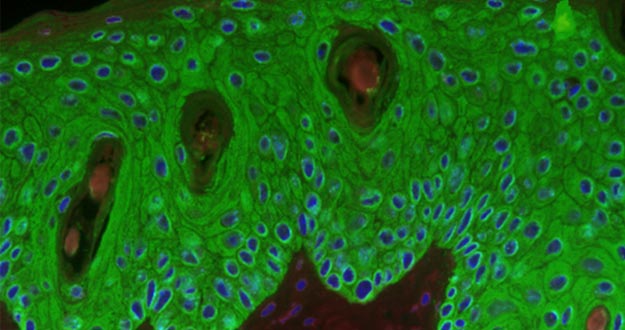
Keratinocytes, with green colour, in the skin of a mouse
In addition to discovering one of the key links in the formation of the skin, they have described this mechanism could be involved in skin cancer, as published in the journal Genes & Development, with Stefanie Wurm, as the first author, and directed by Erwin Wagner, head of the BBVA Foundation-CNIO of Cancer Cell Biology program.
And in the formation of human skin involves a cascade of not yet well known biochemical signals; but very important, since their failures cause diseases, that affect more than a quarter of humanity, from atopic dermatitis to skin cancers.
Specifically, the authors have identified the Fra-2 protein, whose precise role in skin, until now it was not known, as a key element, in the differentiation of keratinocytes: if Fra-2 is not activated, there no differentiation and, therefore, the skin is not completely formed.
Human keratinocytes live about a month and, in that period, they go through a series of changes, related to the different functions, performed during its journey, from the deepest layer of the epidermis, where they are born, until the surface, with which our body touch outside.
This evolution of the keratinocyte is called differentiation. As the authors write: "in the epidermis, the induction of keratinocyte differentiation is essential for the acquisition of the barrier function of the skin, as well as homeostasis [Stability] of the Tissue".
In recent years, it has been unraveling the forest of biochemical signals, involved in the transformation of the keratinocytes and the epidermis formation.
We now know that the process is led by a plethora of genes, located in the so-called Epidermal Differentiation Complex (EDC). In turn, the expression of these genes is regulated by the coordinated interaction of biochemical signals, that send small proteins, like the transcription factors.
The work, now published, shows that Fra-2, one of those transcription factors, plays a key regulatory role. "With the help of specific mouse models, we show that the expression of Fra-2 in keratinocytes, also induce the expression of genes in the EDC", the authors write.
Conversely, it is enough the loss of Fra-2, in the keratinocytes of the suprabasal layer, to cause defects, that prevent the proper functioning of the skin, as a barrier, because it has been reduced the expression of genes EDC. They even found a possible link to cancer.
In mice, prone to develop benign skin tumors (papillomas), the risk of this occurring was reduced while activating Fra-2. The authors attributed to Fra-2 induces premature differentiation of carcinogenic keratinocytes.
Another novelty is related to the way in which the regulation of Fra-2 takes place. The work reveals that the activation or not of this transcription factor depends on the chemical changes, experienced by its interaction with Ezh2 and ERK1 / 2 enzymes, that works a real switch of Fra-2.
This activation method was not known, and researchers now want to study whether it is also involved, in other processes. "We describe a novel interaction of Fra-2 with Ezh2", explains Stefanie Wurm.
"Using techniques of mass spectroscopy, we identified a new posttranslational modification of Fra-2: when methylated by Ezh2 [methylation is a chemical modification, thanks to what the molecule gains a methyl group], Fra-2 remains inactive in the basal cells, and when it is phosphorylated ERK1 / 2 [addition of a phosphate group], it becomes active again".
This finding opens new avenues to explore "if this switch is a general mechanism for activating transcription factors", continues Wurm.
"We also want to study whether inhibition of Ezh2 may be a valuable therapeutic strategy, against skin diseases, related to failures, in keratinocyte differentiation."
Well, I hope that researches continue working, in order to eliminate diseases like Cancer, all over the world.
Until my next post, kind regards,
Luis.
Sponsored by Costaluz Lawyers.
Please click below:

 0
Like
Published at 11:30 AM Comments (0)
0
Like
Published at 11:30 AM Comments (0)
The wonderful cherry in the famous Valley of the Jerte, Spain
Friday, January 16, 2015
Today, I want to talk to you about the Valley of the Jerte (Extremadura).
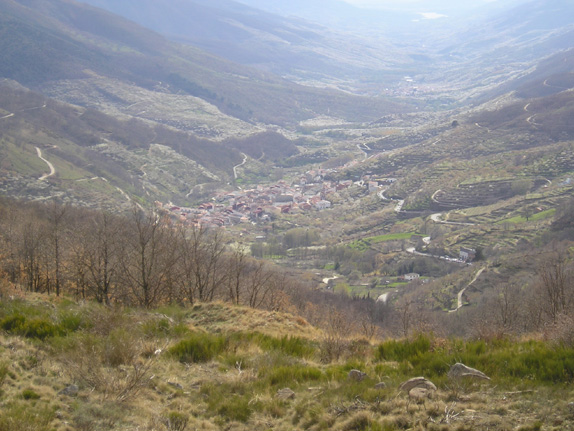
The Valley of the Jerte
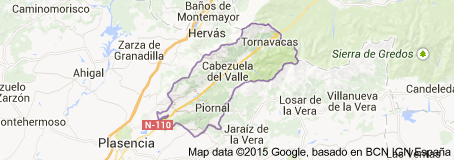
In this Valley, you can find surely the best “picota cherry”, in Spain, and, probably, in all the world.
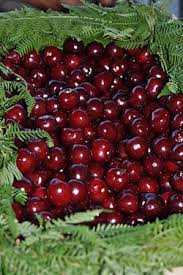
Picotas cherry
I want to show you a video, where you can see how they pick picotas cherry. If you want to watch the video, please click on the link below:
http://www.rtve.es/alacarta/videos/agrosfera/agrosfera-mucho-gusto-picotas-del-valle-del-jerte/2640455/
Voice in off: “Anibal spent two weeks, picking picota cherrys and looking up to sky, because it is concerned that a storm spoils a good campaign”
Anibal del Alta (Producer of picotas cherry): “In a matter of kilos, it is a good campaign, in kilos; what happens is that in calibers, it will be the thing a little loose, because there is much ... well, are the cherry trees... ..cheery trees they have enough kilos. Then, having much load, the fruit will not develop these calibres of 28 or 26 ...; will be some gauges 24, 26 ... Enough "first", a little bit of "chocolate"……”
Voice in off: “In the Jerte, hope to collect, cherry, 35 million kilos, of which 10 are in picotas cherry. A production, that 65% goes to foreign markets”.
Pilar Diaz (Technical Director of the Denomination of Origin): “Cherry of the Jerte”): “Our main markets are: UK ... and, then, it is exported to countries like Germany, Italy .... and, this year, it has been made, together with the Government of Extremadura, we have made a promotion campaign, in Denmark, Estonia and Brazil”
Voice in off: “Are the earliest picotas cherry, which are produced in the bottom of the slopes. As the days pass, they will be collected those above, the sweetest and valued, by the hours of sun they receive. When they finish, on the field, begins the work of them”
Ana Isabel Beato (Cerecera = a woman dedicated to prepare cherry): “This work has always been ... it has been made by women.... calibration is more…….it is a delicate job, you have to do it with patience ... Cherry is a very delicate fruit and then women are always responsible of doing it”
Voice in off: “Here, they take away the leaves or any other debris. At the entrance of Cooperatives, pass quality control; then, they separate them by size; and next, they clean them; then, they are ready for packaging”.
Nicolas Morales (Manager of the Cooperative of the Campo Navaconcejo): “The price of picota cherry does not vary much, from year to year. Prices are usually more or less, agreed. Then, in England, this year the price, per kilo, is 5 cents higher than the last year. In Spain: something similar. The good thing, that picota cherry has is that the price is already known about in advance”
Voice in off: “With small size, very tasty and crunchy texture, the picota cherry from the Jerte is ideal to accompany manufactured dishes, such as is proposed by the prestigious chef, Jesus Almagro: one with meat lamb neck, because he says about it that.... ..”
Jesus Almagro: “All of this nust be eaten: from the head to the neck; so we used today this part, really ... usually not used to make a dish of haute cuisine”
Voice in off: “Cooked at low temperature, marked in skillet and heat stroke in the oven; It is paired to perfection with others products from Extremadura, as Serena cheese, liquefied. Accompany it with Migas (typical dish of the Aragonese cuisine made with bread crums, olive oil, grapes and pork) with paprika and, of course, with candied cherry on cherry liqueur”.
Jesus Almagro (Chef): “That neck of lamb confit, it will be very honeyed --which stays stuck with you--, but, drape it with a cherry, it will wash your mouth, it will leave your mouth much cleaner, to return to eat that piece of lamb”
Voice in off: “Cherries and picotas cherry, for marry (combine) with savory dishes; but, above all, in a variety of desserts”

Cherries with chocolate
Jesus Almagro: “What I like is that it is seasonal: ....... that cherry is seen only once .....; it is not like tomatoes, that you can bring .., or cucumber or peach or pineapple ... No, no, no .... here are just cherry, coming out in May, June and .......... and ..... and it is over”
Voice in off: “And moreover, the picota cherry, from the Jerte, is unique for its high vitamin content, its antioxidant and moisturizing properties”.
Well, I hope that you can come to the Valley of the Jerte and eat this wonderful fruit.
Until my next post, kind regards,
Luis.
Sponsored by Costaluz Lawyers.
Please click below:

 0
Like
Published at 12:22 PM Comments (0)
0
Like
Published at 12:22 PM Comments (0)
The etymology of the word “Fable” from the Latin to the Spanish
Wednesday, January 14, 2015
Today, I want to talk to you about the word “Fábula” (Fable).
This word, in Latin, means: Conversation, rumor and, from there: legend or myth.
The Fable is a literary genre very present in the Classical Literature.
Fabula comes from the Latin “Fabula”, which originates in the verb For, Fari, Fatum, meaning Talk. From “For” comes “Fabula”(Fable). From Fable comes “Fabulari”, that in Spanish is “Hablar” (To talk). In Galician and Portuguese: “Falar” –you can see that it maintains the F--. In Italian: Fabolare. And also in Spanish we have the verb: “Fabular”. And: “Fabuloso”, that means: “Extraordinary” (something incredible).
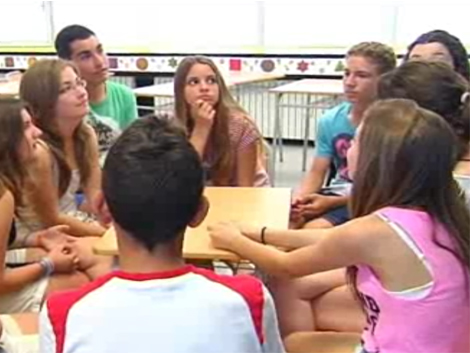
A group of spanish young people talking between them
The verb “To talk” in Spanish is so curious, because etymologically means “To tell stories”. So, when we are talking, really we are telling stories.
Before I talked about the verb Far, Fari, Fatum. Well, “Fatum” means that it is “said”, destiny of each one.
From Far, Fari, also comes: “Fanum”, that means: “Sanctuary” (the gods´place. Where they pronounce divine words, fades). At the same time, who stayed out of temple was: the “Profane”; it also means: “Who knows nothing”.
By other side: “Fanatic” –in Latin: “Fanaticus”— is who defends religious beliefs blindly.
The Spanish word “Fatal” also comes from “Fatum” and goes to “Fatalis” (What is said, what is fixed by fate). At the beginning it was not negative; but when time was spent, it became something
And from “Fatum” also comes “Hada” (Fairy).
And the word “Fama” (Fame). It comes from Fatum. Fame is what you talk about, the news that runs from mouth to mouth. When yo talk well about anybody, it is famous. However, when you talk bad about anybody, you are “difamando” (defameing).
What can not be talked is (“Infable”).
And whom you can talk, is “Afable”. It comes from “Adfabilis”.
Well, I hope that you have enjoyed.
Until my next post, kind regards,
Luis.
Sponsored by Costaluz Lawyers.
Please click below:

 0
Like
Published at 5:39 PM Comments (0)
0
Like
Published at 5:39 PM Comments (0)
The tourist growth in Spain
Tuesday, January 13, 2015
The General Secretary of the World Tourism Organization (WTO), Taleb Rifai, said that Spain is in the "right direction" with changes in tourism, although it is a "model set", while he has highlighted the "biggest interest" to Fitur.
Speaking at the Europe Forum, organized by New Economy Forum in Madrid, Rifai said that tourism in Spain "focuses increasingly on people and the tangible and intangible cultural assets" which mimics "increasingly" the rest of the world.
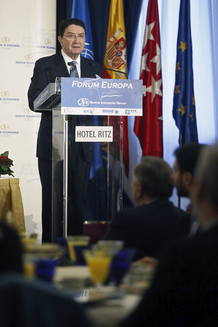
Taleb Rifai
Rifai has assessed that Spain "has been able to face the major challenge of seasonality" to what they have created institutions and operations, that "run along the whole year, instead of 45 or 90 days a year".
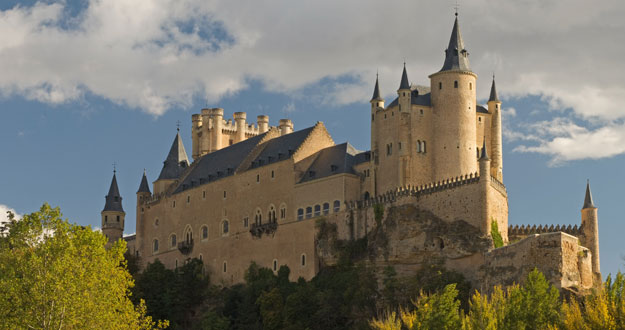
The Fortress of Segovia
Likewise, the General Secretary of UNWTO has referred, to the International Tourism Fair of Madrid (FITUR), to be held from January 28 to February 1 in Madrid, and each year produces an "bigger interest" in the sector, which Rifai has exemplified, referring to the informal meeting, organized by the WTO, to attend this year 45 ministers, from around the world, compared to 26, last year.
The WTO has indicated that it hopes for "more serious efforts to connect Europe by train", within the EU, as it is a means of transport, that would expand freedom of movement of people, between member countries.
In addition, Rifai said that a challenge, for 2015, is the regulation of so-called collaborative services, that are "creating a problem", by putting, into a question, to some operators.
Also, he referred to the rise of the Internet, the development of sustainable and universally accessible tourism, as other challenges of 2015.
Asked about the growth of medical tourism, Rifai have preferred the term “wellness tourism”, as it helps to make the visitor feel better, with a complete package, and he has avoided ruling, on how to combat this type of visits involve a cost to the coffers of the recipient country.
Otherwise, since the WTO has been assessed positively the decrease, in oil prices, for airlines, as lowers costs and this influences the prices of travel, but otherwise has suggested that it reduces the purchasing power of residents, in oil producing countries, which also affects tourism.
Regarding the evolution of the sector, Rifai has advanced 1,100 million tourists, in 2014, brushed worldwide, a figure confirmed, during the next edition of Fitur, and has also been worth the increase, in young traveler and visits, to developing countries, which continue to grow this year.
Well, I hope that you are one of themany million tourists, who will visit Spain on this year.
Thank you for reading my blog and, until my next post, kind regards,
Luis.
Sponsored by Costaluz Lawyers.
Please click below:

 0
Like
Published at 12:49 PM Comments (0)
0
Like
Published at 12:49 PM Comments (0)
Fresh fish in Cabo de Gata, Southeastern Spain
Tuesday, January 13, 2015
Today, I want to shw you a video, where you can watch how fresh is fish in Cabo de Gata. If you want to watch this video, please click on the link below:
http://www.rtve.es/alacarta/videos/aqui-la-tierra/alt-pescado-cabo-gata-261214/2929234/
The presenter: “Pepe….Cabo de Gata….I could not wait to come……!”
Pepe: “Thank you very much, man, for your visit”
The presenter: “That is…….I come fortalking about fish…and I see the table empty….”
Pepe: “If you wait two minutes, and I will bring you cooler, cooler, cooler little fish ......”
The presenter: “Fresh?”
Pepe (Chiribus): “Fresh, until it can not any more…”
The presenter: “Are you going to the fish store or it is closed until the weekend?....”
Pepe: “Nothing!”
The presenter: “To the stock?, are you going to the association…”
Pepe: “Nothing……Even better…………...”
The presenter: “I wait for you here”
Pepe: “Wait for me…two minutes”
The presenter: “Come on, Pepe!”
…………Music…………..
Pepe: “Dalo….What……..?”
Dalo: “But..look….I have arrived now…..Here I bring a couple of little squids…..take you them…..”
Pepe: “Yo pass over there and you drink a “Cañica” = little “caña” = little beer….when you want….”
Dalo: “Come on….and we will settle up a score….”
…….music………………..
Pepe: “Good morning, Paquito…”
Paquito: “Good morning, Pepe….”
Pepe: “What do you say…?. What do you bring…?”
Paquito: “….a couple of large pins and the jarreras”
Pepe: “Oh my!...the pin, that is so good, made into slices fried…..it is scrumptious…..”
Pepe: “Oh…my….They are alive….!”
The presenter: “Have you the fire ready?”
Antonia (The lady cooker): “I am going to prepare it right now…..”
The presenter: “See you”
The presenter: “Maaaannnn……!....Pepe…….”
Pepe: “How are you, friend?”
The presenter: “Fresh fish….”
Pepe: “Little, fresh, little fresh….”
The presenter: “Where do you bring it from?”
Pepe: “From the small boat….What better fish you can eat, that comes directly out of the boat to here?”
The presenter: “Listen to one thing, Pepe .... there you have your fish store, directly ....”
Pepe: “Yes, sir”
Pepe: “You take it from the net, you rinse it a little bit, I see if it is around .... or they come, they bring .... It is a prawn bay, here in front: Cape Bay Gata ................... yes mullets are San Jose .... This, Paquito, there in front, with the net ... the spit, the blacksmith ....”
The presenter: “Which fish is taken: The King or the Queen?”
Pepe: “Bravo that waitress ....”
The presenter: “Jacob, I know I am going to make you jealous ... we are living the holidays, here in Cabo de Gata, in short sleeves. Is not it, Pepe?”
Pepe: “Maaaaannnnn!. It is not cold….we are at 22 degrees….”
The presenter: “Very weeeeell…….We say goodbye….Cabo de Gata….The applause…”
Pepe: “That applause…….”
Well, I hope that you have enjoyed with this story. Until my next post, kind regards,
Luis.
Sponsored by Costaluz Lawyers.
Please click below:

 0
Like
Published at 12:43 AM Comments (0)
0
Like
Published at 12:43 AM Comments (0)
Some lakes with large genetic wealth in northeastern Spain
Friday, January 9, 2015
Many times, we the Spaniards do not know the wealth, that we have in our country. And, in this sense, I did not know that, in the northeastern Spain, there are some lakes with more wealth even though than sea.
Yes. These lakes are located so high –one of them, at 1,590 meters--:

Pond D´Oles, Gausac, Lérida, Valey of Aran, North eastern Spain
The high mountain lakes of the Aigüestortes National Park, in the province of Lleida, have a greater genetic wealth than existing on the surface of the oceans. This one was revealed by a biocomputing tool, to characterize and catalog the microbial ecosystems in natural environments, based on their genetic wealth, used by a team of researchers, from the National Research Council (CSIC).
The study, published this Thursday, in the journal Molecular Ecology, has compared the data, obtained with the new tool, with previous studies on the microbiota of the most superficial part (up to five meters deep) from oceans, reported by the CSIC.
The results show that, while the chemical and geological variability of oceans is very homogeneous on surface, along thousands of miles, in the protected alpine lakes of Aigüestortes, this variability is very high, for short distances, on the order of a few kilometers.
"It is a contact zone of three types of geological substrates, which makes it unique compared to other alpine areas", said the researcher from the CSIC, Emilio Casamayor, from the Center for Advanced Studies of Blanes.
"All these factors allow developing very different species, in very short distances, accumulating in all a great genetic wealth. It also allows us to consider, for the first time, the possibility of developing conservation studies with microscopic creatures", added the scientist.
Casamayor has also stressed that, for the first time, they have been able to approach the study of microbial communities, without having to catalog or identify the species individually. It was thanks to the genetic information, that they have recovered directly from natural environments, he stated.
"This allows us to characterize, in synoptic manner, as a whole, microbial systems and observing, through an objective tool, how they are organized and function of biological communities and whether they deserve it or not to be exploited or preserved", he explains.
Moreover, he adds: "It is a very useful approach to advance in the knowledge of ecology and evolution of the microbial world; but, also, it has applications in studies of bioprospecting or conservation".
As explained the researcher of the CSIC, microorganisms were the first living beings to appear, on Earth, 3,000 million years ago. Since then, they have been interacting with the chemistry and geology of this planet and have learned to use a wide repertoire of energy sources and food for their survival. Their diversity is not in their shape or size, but that hides in their metabolism, which is codified under a wide genetic variability. That metabolism, combined as a line work in microbial communities, is what remains the viable biosphere.
Well, I think it is very interesting and I have been surprised, as I told you at the beginning. I hope that you have liked this news.
Until my next post, kind regards,
Luis.
Sponsored by Costaluz Lawyers.
Please click below:

 0
Like
Published at 12:27 PM Comments (0)
0
Like
Published at 12:27 PM Comments (0)
A Spanish device disinfects food with ultraviolet light
Thursday, January 8, 2015
Some days ago, I could read an interesting news: A new device created in Alicante disinfects food with ultraviolet light. Then, I would like to show you the explanation.
Ultraviolet light radiation, which is a part of sunlight and it can cause adverse health effects, is now revealed as an "ally", effective in disinfecting food, through a patented device internationally, by three researchers from the Department of Analytical Chemistry, Food Science and Nutrition, of the University of Alicante (UA).
The device, which mainly disinfects liquid food, such as horchata, juices and wine, is able to eliminate, cold, the biochemical contamination of these foods, without affecting their organoleptic characteristics.
The technology, developed by these scientists, is based on the irradiation of ultraviolet light to food and, as its creators affirm, it is totally safe for consumers and it eradicates pathogen agents, quickly and safely. Moreover, the system has advantages, such as its low cost.
The development of this system arose from the demand for a national company, headquartered in Jijona (Alicante), dedicated to the manufacture of machinery for the sectors of ice creams, candies, sweet and treatment of almond.
They proposed to find an alternative to the use of bleach, to disinfect groundnut, ingredient with which the horchata is made.
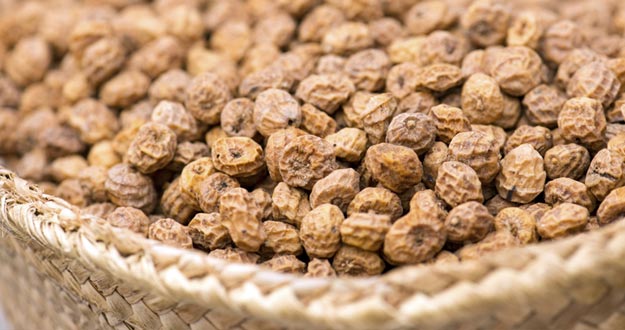
Groundnuts
After a couple of years of work and an assistance, from the Centre for the Development of Industrial Technology (CDTI), under the Ministry of Economy and Finance, the device, devised by the UA, has been successfully tested, in the disinfection of opaque food fluids, ie, it lets no light through (horchata, juices and wine).
Now, that company, based in Jijona, Mechanical Jijonenca SA (Mejisa), is making the system, invented by the three researchers of the AU, for marketing.
The Professor of Analytical Chemistry, at the UA, and responsible of this research, José Luis Todolí, explained that, usually, physical or chemical treatments, to disinfect food, are used during the manufacturing process.
However, chemical methods can produce harmful byproducts, to be removed, while processes as the pasteurization --a technique applied, mainly, in dairy or juices-- suppose a thermal shock, that can affect the organoleptic characteristics of the food.
Todolí noted that food, once disinfected, "can become infected if, for example, remain stored". "With our system, unlike pasteurization or methods using chemicals, food can be disinfected, as often as we want, unmodified qualities", said the researcher, who has indicated that they have already registered the patent application.
Therefore, the patented technology, by the AU, can replace widespread processes, such as pasteurization, being less aggressive with food and allow values similar to current disinfection.
This system, whose world premiere will be next February, at the International Fair Ice Cream and Related (Intergelat), which is usually held, at the Institution of the Fair of Alicante (IFA), in Elche, may be applicable also in surface disinfection of any solid product.
Now, the three researchers want to use it for disinfection of solid foods and the production line in the food sector, where bactericidal detergents are used, has advanced Todolí.
Well, I hope that you have liked this news.
Until my next post, kind regards,
Lui.
Sponsored by Costaluz Lawyers.
Pleas click below:

 0
Like
Published at 11:40 AM Comments (0)
0
Like
Published at 11:40 AM Comments (0)
Three King´s cake in Spain
Wednesday, January 7, 2015
Today, we have celebrated, in Spain, the “Three King´s Day” --or according to Catholic tradition: The “Epiphany of the Lord”--. And one of the things, that characterize this day is the "King cake" (a kind of sweet bun, which leads into a figurine gift. It is usually bought for breakfast or snack).
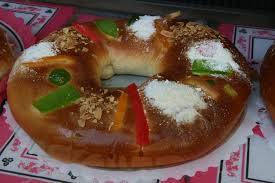
King cake
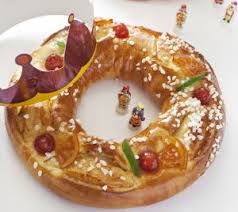
King cake with figurine gift
I have shown you one King cake unfilled. But you can also buy a stuffed King cake cream. Here you have an example:
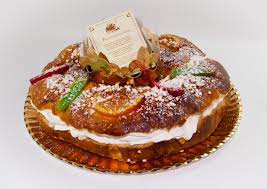
Stuffed king cake cream
I would like to show you a video, where it is explained how to cook a King cake. If you want to watch this video, please click on the link below:
http://www.rtve.es/alacarta/videos/aqui-la-tierra/sin-este-dulce-no-hay-navidad/2938934/
The presenter: “Marta and Isabel, who now are going to prepare, for me, a Christmas sweet, very typical, that we can not disclose, until we finish .... What carrys it within?”
Marta: “Well, look, first let us do, a little bit, what are the aromatic components: first ... well, butter, let us put a little bit of butter .., which is fat, what absorbs flavors well .. ., we will put rum, sugar, a little bit of salt, which will give .....”
Isabel: “You always have to pour salt to all sweets, to mix flavors well”
Marta: “………After: orange zest and lemon zest”
The presenter: “Is your daughter making it well?”
Isabel: “She does it so perfectly, she is a gem….”
The presenter: “And with this, what do we do now?”
Marta Cardenas (The Isabel Maestre´s Bakery): “We are going to put it to heat and, when it has tempered a bit, when it is about 28 degrees, we will add it to the flour, with the yeast and ....”
The presenter: “Do not tell more, do not tell more, that if you do it, we will know what it is about…..”
Isabel: “Look, Mar: here we have the mix, that we have made on fire….”
Mar (the presenter): “Now, what do we do, Marta?”
Marta: “Well, we will add orange blossom water, which is the most important ingredient of this sweet ...”
Mar: “We have said one key..¿Eh? ... Let us see if people do know it......”
Mar: “What do we pour…?”
Marta: “First ... over here, flour ... I will put it in the robot ....”
Mar: “And…If we have no robot at home..……by hand?”
Marta: “By hand or…., if not, buying it in an artisan pastry …..”
Mar: “How much of flour we have poured?”
Marta: “Half kilo. And now, I will leave this amassing a very long time, as if it was a brioche dough, until it is a smooth mass and with an elastic consistency”
Isabel Maestre (The Isabel Maestre´s Bakery): “Now we are going to take it out the bowl and we are going to move it here, to ferment”
……music…..
Isabel: “It is already to shape it…”
Mar: “Let us see what form has this sweet .... What are you checking, Isabel?”
Isabel: “What I want is to do the little hole, immediately”
Mar: “........ It everything seems indicate…………that what I have in my hand ..... you have to insert it into ............. Hey ... Where do I put this one………whererever ....?”
Isabel: “Here within…”
Mar: “But it is very big….”
Isabel: “No, no, no…..it goes up later…….You have to paint it with egg”
Mar: “Well…., what an impression has this king cake….!”
Isabel: “What a good impression…..Is not it?”
Mar: “Lack a little decoration, Is not it?”
Isabel: “Of course. Now we are going to do it”
Mar: “What do you pour to it?”
Isabel: “We will now paint it with apricot, almond, sugar and orange”
Mar: “Is King cake eaten only at Kings time or may we take it all the year?”
Isabel: “All the year. And we have to try that it is an our dessert, como el Panetone, que el Panetone is taken all the year and you have to try that King cake arrives to be taken all the year too”
Mar: “Well..chin chin…..Chin chin of King cake, cause of the Christmas Time……”
Well, I hope that you have enjoyed with this video. Perhaps a day you want try to cook a king cake like this one, Do not you?.
Until my next post, kind regards,
Luis.
Sponsored by Costaluz Lawyers.
Please click below:

 0
Like
Published at 10:52 AM Comments (0)
0
Like
Published at 10:52 AM Comments (0)
Museum of miniatures in Spain
Monday, January 5, 2015
Did you know that in Spain there is a Museum of Miniatures?. I did not know it, until today.
If by collecting, we understand the action to collect a set of things of the same class, we will realize that in one way or another, in reality, most people are collectors of something.
Collectibles items may be intangible or tangible and, curiously, traveling can be a good way to collect both types of things.
A traveler collects experiences, feelings and memories, the latter may also be something physical that you can see or touch. Rare is the traveler, who, at some point along one of his trips, have not purchased anything in memory of a destination or a place.
Well, a great and particular example of traveler and collector of things (tangible), we can find, in the small town of Brihuega, also known as the Garden of the Alcarria.

Brihuega, Guadalajara
This nice village of Guadalajara, located an hour from Madrid (90 Km), saw the birth, in 1912, of John Chosen Millan (an anonymous person, who, over the years, become a popular character, the Teacher Max.

The Teacher Max
This curious neighbor from Brihuega, initially a doctor, a professor and a journalist, became famous as a mentalist and this allowed him to travel, around the world, by offering experiences of hypnotism and suggestion. They say that he was the first mentalist, who was able to hypnotize, by phone and by photography.
His striking activity and his adventurism gave him the opportunity to travel, to many parts of the world, awakening turn him a concern, to collect memories of small size. Which resulted in a large and interesting collection of miniatures, composed of thousands of pieces of unique value, over the years.
His passion for collecting tiny things was such that, in 1972, is open, in Mijas, the first "World Museum of Miniatures", called "Wagon Max", which housed 30,000 pieces and is still open today.
After the death of the Professor, in 1975, his sister and her husband opened, in 1977, the "World of Max", in Guadalest (Alicante). That museum gets numerous awards and honors for its work, including a Guinness record.
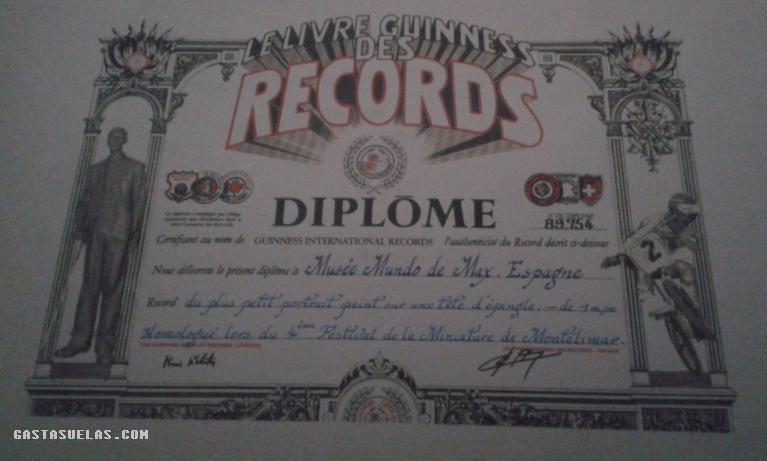 A Guinness Record A Guinness Record
But it is, ultimately, the nephew of the Professor, who takes charge of the exhibition and he moved the museum from Guadalest to the Mancha region, placing the exhibition, definitely, in Brihuega. The Professor´s place, regardless of how far it was found, cause of his work, he always came back, every year, to visit during festivals and collaborated in the procession of the wax (party of provincial touristic interest).
The village of Brihuega kindly allowed the exposure of his illustrious neighbor from staying in one of the landmark buildings of the village, the Convent of San José. An old building, that was seized, from the Church, through the “Confiscation of Mendizabal” and served as a hospital, prison, school workshop and court, before becoming the World Museum of Miniatures, “Professor Max”.

The Convent of San José
The old and well preserved facade of the convent is far from the modern design of the exhibition hides inside, this being the first surprise, that the museum offers to its visitors.
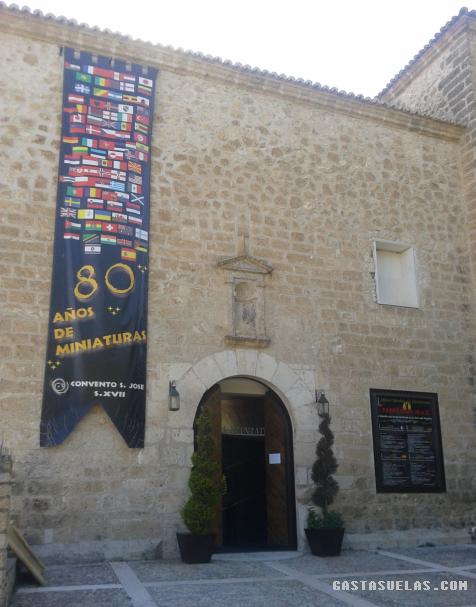
Main entrance of the Convent
The entrance to see the exhibition may seem somewhat expensive, at the begining, € 6.50 per person (children under 3 years free); but bear in mind that the museum receives no subsidy and that proceeds, through gate passes, expenses and maintenance of the museum are paid.
Once inside the museum, the tour is not very long, since to house miniatures, it does not take much space. But what we need are good lenses increases, without which it would be virtually impossible to see some of the exhibits. So many of them, presented and protected inside cabinets, transparent columns or circular exhibitors, have magnifying glasses, to see, with some comfort, the scope of the miniatures.
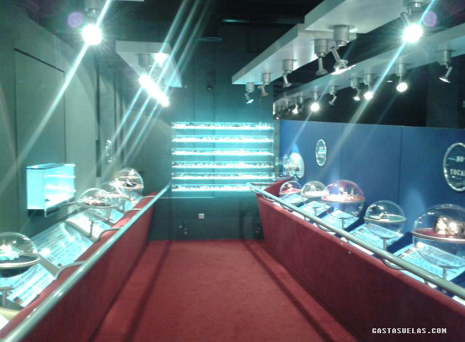
Inside of the Museum
The entrance to the museum is dominated by a life-size figure of Professor Max and his exhibition offers numerous pleasant surprises to its visitors. You may find, among a myriad of things, a carved stick a match, small sculptures made of chalk, a couple of fleas dressed as newlyweds, a manuscript on the edge of a business card, a wide collection of shoes tiny, clear paintings on the head of a pin, one bullfighter task at the head of a match, many little dollhouses and hundreds of small and dwarf pieces, from various corners of the world.
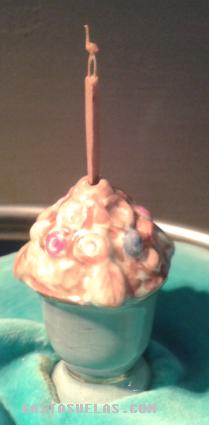
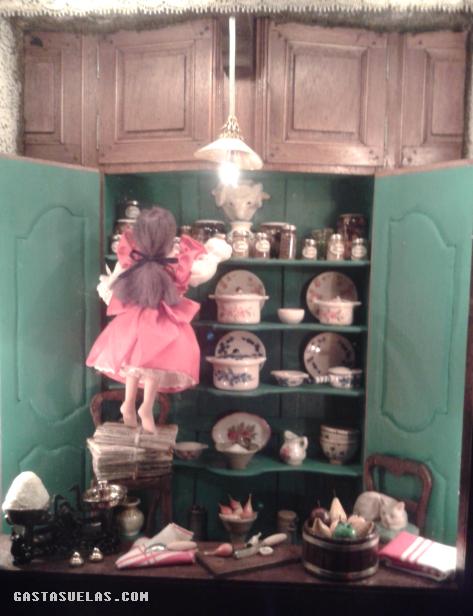
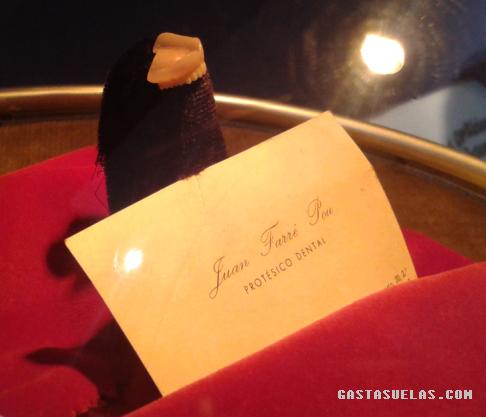
A small dental prosthesis
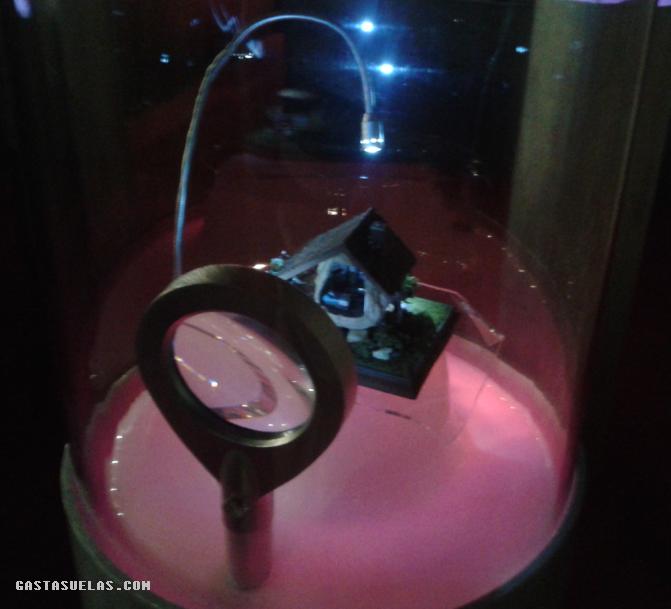 A little house inside a walnut A little house inside a walnut
But, between all the things displayed, two things reduced in size especially draw attention to the rest, though for very different reasons.
The first, is a copy of the “Last Supper”, by Leonardo Da Vinci, on a grain of rice. Not that the replica is accurate, much less, but through the loupe can perfectly be seen the amazing work, in miniature.
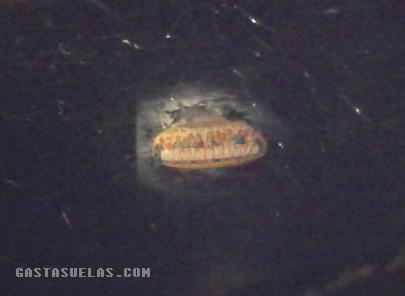
The "Last Supper" inside a rice
How was it possible to paint on a grain of rice to Jesus and his twelve disciples?, because, as we were indicated, in the museum, the author used a hand hair and holding his breath, was giving tiny strokes to rate heartbeat to define tiny painting.
Finally, it could not be otherwise, on leaving the museum, you can buy souvenirs of the place. Thumbnails of various types, for anyone collector of memorabilia or small things.
Although the museum of the Professor Max is a good incentive to visit Brihuega, the town itself has many charming corners, that invite to be known, whether they sooner or later decide to visit that exhibition of miniatures.
Brihuega has a broad artistic heritage, whose origin derives from passing by Romans, Arabs, Catholics and Jews.
Among the things you can see and visit, we found the Old Castle, several churches, the Wall, ancient arches, into town, and the bullring.
Well, if you want to visit Brihuega and its Museum of Miniatures, you can see this little map:
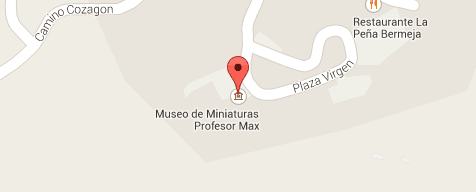
Convento San José Plaza de Manuel Leguineche, 2, 19400 Brihuega, Guadalajara, Spain.
Telephone number: +34 949 28 01 52
Until my next post, kind regards,
Luis.
Sponsored by Costaluz Lawyers.
Please click below:

 0
Like
Published at 11:53 AM Comments (0)
0
Like
Published at 11:53 AM Comments (0)
A different Music by Bach for children in Spain
Friday, January 2, 2015
Today I bring you a very funny video, where a group of artists performs music of Bach, for children, halfway between Jazz and Electronic.
If you want to watch this video, please click below:
http://www.rtve.es/alacarta/videos/telediario/tdfs2-ninos-bach-271214/2930334/
Voice in off: “Johann Sebastian Bach surely would have been as surprised as these children, to hear this version of one of his Concerts from Brandeburgo, or even more, halfway between Jazz and Electronic”
Llibert Fortuny (Musician): “What I have tried is closer it to my world, more technological, more improvisation ....; but ...it is great and whatever you do, always works, because melodically it is as strong .....”
Voice in off: “And all this with the most demanding public ...: children”
A child: “that my sister danced sitting for the first time……”
A mother: “It is a very good way, for children, to begin to see live music concerts and other form of listening to Bach”.
Voice in off: “A key songwriter, in the history of Music ... Does it sound to you?”
Sandra Sangermán (Editorial department. Voice in off): “His production is not just for kids: masses and oratorios, to listen in churches, at one time, Baroque, which had not yet invented concert halls”
Assumpció Malagarriga (Director Educational Services, Audience of Barcelona): “Bach is a composer, who many people would say that is not for children; but children can understand any kind of music, like adults…. If we get hit, when they hear, they will want to repeat and want to hear more”.
Sandra Sangermán: “And so bring Classical Music to children”
Well, I hope that you enjoyed this news.
Until my next post, kind regards,
Luis.
Sponsored by Costaluz Lawyers.
Please click below:

 0
Like
Published at 11:54 AM Comments (0)
0
Like
Published at 11:54 AM Comments (0)
Spam post or Abuse? Please let us know
|
|